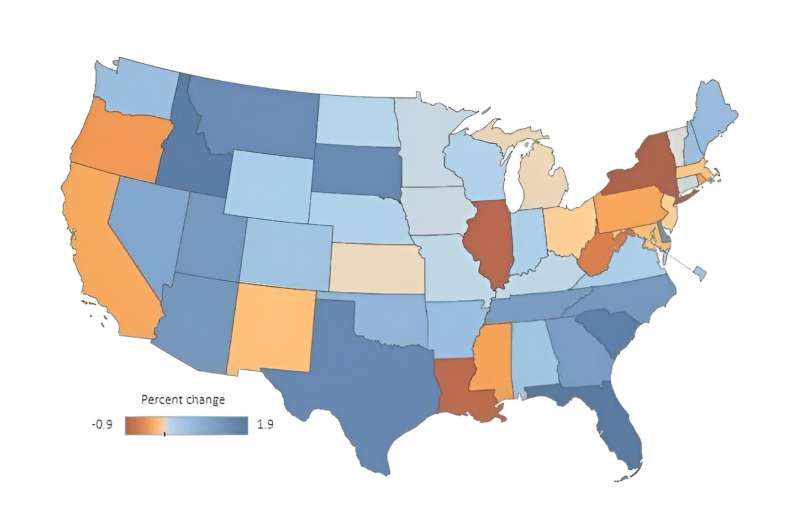This article has been reviewed according to Science X's editorial process and policies. Editors have highlighted the following attributes while ensuring the content's credibility:
fact-checked
trusted source
proofread
Economics propelling population shifts in spite of climate-driven risks: Study

People are willing to live in locations where there is a greater risk of climate-driven extreme weather and natural disasters if there is an increase to their overall economic well-being, according to a study by Douglas Wrenn.
An associate professor of environmental and resource economics in the Penn State College of Agricultural Sciences, Wrenn said the work contributes to a broader dialogue on how communities contend with climate-related vulnerabilities and adapt to risks, offering insights for future policy considerations and community planning.
The research is available online now and will appear in an upcoming issue of the Journal of the Association of Environmental and Resource Economists.
"Over the past three decades, the census has shown the U.S. population has shifted southward due to large numbers of people moving to places like Texas and Florida," Wrenn said. "However, those are places with increased risks from climate change, such as hurricanes, extreme heat and flooding."
Wrenn said this trend would seem counterintuitive but is rational when considering the economic trade-offs involved.
"It's riskier to live in the South, but it's also cheaper to live there," he said. "The wage that you can get conditional to your skill set and the price of housing tends to lead to a real wage bump for people relative to if they were living in another location."
This notion is explained by the concept of equilibrium in economics, which is when the marketplace is balanced because supply and demand are equal.
"By adding a spatial component to the scenario, you get the concept of spatial equilibrium," Wrenn said. "Everybody trades off their preferences for what they'd like to have in life for the price they have to pay to get it."
For example, a person who values a house next to a park may pay more for it.
"The person who values it most will pay that high price, and the person who values it less will pay less but live farther from the park. Eventually everything settles down to an equilibrium," said Wrenn, a faculty member in the Institute of Energy and the Environment.
When this concept is expanded to the continental United States, which is the area Wrenn's paper is focused, the scale moves to what are called commuting zones. These are areas where people commute to or from for work.
"Think Los Angeles or Baltimore," he said. "Now when you're thinking about where to live, you're not thinking about a neighborhood within a city. You're thinking about which one of these commuting zones across the United States you're going to live in."
The actual cost of living somewhere is the ratio of earned wages to the cost of living. As housing prices rise, real wages decrease, highlighting the economic dynamics at play, Wrenn said.
"When we look at the idea of spatial equilibrium, it's not that someone likes the risk. It's that the risk is worth the increased earnings. That's the equilibrium," Wrenn said. "Over the last 30 years, households have traded the increased risk for the rise in real wages from living in these riskier locations."
Wrenn's work also contributes to the efforts of a $17 million Penn State and Department of Energy interdisciplinary project that aims to understand how natural hazards create vulnerabilities and risks for society and how societies respond and adapt to those risks.
"What we're really trying to do now is take this model and link it up with these other infrastructure projects to think about if there are changes to subsidies or policies or wages, how is it going to change people's relative response rates?" Wrenn said. "The initial response of departing might be high, but the feedback effects themselves could dampen some of this effect."
He said this occurs regularly around the United States after big hurricanes.
"People often wonder why individuals in these areas stay behind," Wrenn said. "Intuitively for me as an economist, the answer is that the feedback effects are beneficial to some. Usually, it's wealthy households with high demand that drive housing prices up. If those households leave, they take pressure off, which means rents come down. Now the real wage is actually rising for the people that are left behind."
This phenomenon dampens the probability that there will be an outflow.
"Then you add in government transfer payments which raise wages, and you actually incentivize people to stay in places that are not particularly safe," he said.
While there is a current equilibrium based on existing information, Wrenn underscored the potential influence of climate change on these trends. As extreme weather events become more frequent and severe, coupled with an evolving understanding of associated risks, population trends might shift in unforeseen ways.
"Humans have never regularly experienced such extreme heat, more rapid and severe hurricanes, flooding and sea level rise," Wrenn said. "Historically, government policies have masked the risks associated with living in some of these places, particularly with flooding. As the information starts coming in about what people can expect, not over the last 30 years, but what to expect going forward, population trends may go in the other direction."
More information: Douglas Harvey Wrenn, The Effect of Natural Disasters and Extreme Weather on Household Location Choice and Economic Welfare, Journal of the Association of Environmental and Resource Economists (2023). DOI: 10.1086/728887
Provided by Pennsylvania State University


















